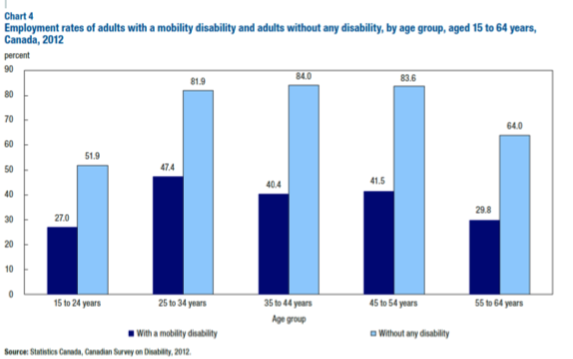Stigma and Discrimination (Part 2)
1/22
There's no tags or description
Looks like no tags are added yet.
Name | Mastery | Learn | Test | Matching | Spaced |
|---|
No study sessions yet.
23 Terms
measuring stereotypes and discrimination
It is really challenging trying to measure stereotypes (people often don’t disclose their biases, or their true opinions on stereotypes and discrimination)
Canadians
half of canadians accept job disability discrimination
understandable if an employer thinks it’s too risky to hire someone with a physical disability
proportion and number of complaints received from 2009 to 2013 by jurisdiction and disability status
50% of the complaints are related to disabilities
mobility disabilities (2017)
2.7 million Canadians 15 years and older (9.6%) have a mobility disability
restriction in their participation due to environments not being accessible 19.7%
mobility disabilities among canadians aged 15+ (2012)
working age adults (15 to 64) with mobility disabilities had overall lower levels of educational attainment than those who did not have any type of disability
32% or 1/3 of people said that they do feel excluded due to their disability

canadian data
people without disability are more likely to be employed in all age ranges
large portion of all discrimination complaints are disability related
nearly 1/5 of employed adults with a mobility disability indicated that their employer was unaware of their condition
54% feels employer considers them disadvantaged
52% feels disadvantaged

PSD
physical or sensory disability
physical: having an amputated limb, cerebral palsy, etc.
sensory: visual and hearing impariments
PSD: concelable
PSD
blindness, spinal cord injury, multiple sclerosis
fear of being discovered may influence level of stigmatization
may play a minor role in visible conditions
favours feelings of guilt, shame, and anxiety for those who have a non-visible condition and who hide their “real body”
PSD: course of the mark
PSD
that is progressive in nature
when the person faces more limitations and has more apparent symptomology = possibility of increased stigmatization
PSD: origin
PSD
that are perceived as inevitable and uncontrollable
positive response of observers (“us”)
that are provoked by the person with PSD, due to negligent behaviours
negative reactions, rejecting and hostile towards “them”
PSD: disruptiveness
PSD
perceived stigma is directly and positively associated to the level of interference with verbal and physical communication
increased interference = increased stigma
link with concealable and course of the mark
PSD: aesthetics
PSD
direct link with concealable
individuals with disability or disfiguring illness are universally avoided
“us” = visceral sensory response of discomfort, threat to body image, anxiety
PSD + unpleasing aesthetics may provoke stigmatizing reactions (rejection/avoidance)
PSD: peril
PSD
more associated to psychiatric conditions
if visible + severe: generates reminder of serious vulnerability and mortality
life is unpredictable and uncontrollable
leads to uneasiness, anxiety, and the need for social distance (for “us”)
PSD: stigma
PSD
public stigma: continues to constrict their opportunities to integrate and participate fully in community life
reduce with research to change negative attitudes with legislation for people in situations of disability
goal of Fraser study
examine how the media contributes to create and maintain ageist stereotypes in relation to the double sensory loss and technical aids
why: if there is a public stigma of older adults in relation to technical aid use, it could reduce help-seeking and use of technical aids
Canadian newspapers
The Globe and Mail
La Presse
4 contexts
autonomy
help-seeking
employment
politics
stereotypes (older adults…)
are incompetent
are vulnerable
*most frequently found (likely that #4 is number 1)
autonomy context
context
concealable
recognize the importance of technical aids, but don’t want others to know
course of the mark
deterioration of health conditions lead to dependence
irony
technical aids can facilitate autonomy, but people are afraid of discrimination
help-seeking context
context
presentation by media: changes in health are “normal”
no need for treatment or help (if it is considered normal)
erroneous perception of those who seek help
employment context
context
dichotomy
“older workers rock”
but changes in health are probably a weight on the company and the “special needs” must be accommodated
possibility that older adults hide their changes in health for fear of discrimination
politics context
context
older adults are presented as a weight on the health system that must be resolved
vulnerable “us”/ we must take care of “them”
“triple whammy”
ageing
changes in health
using technical aids
high possibility for many stereotypes and discrimination